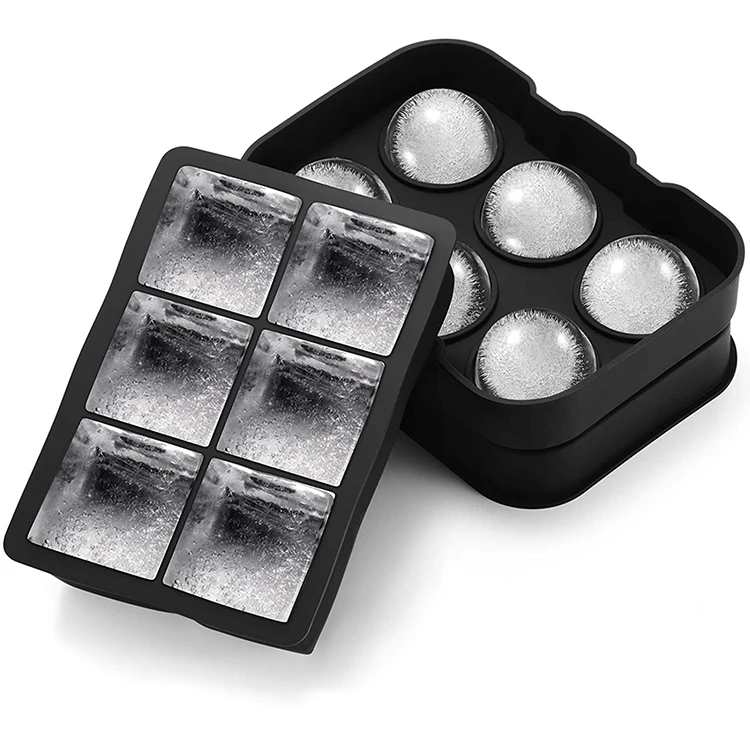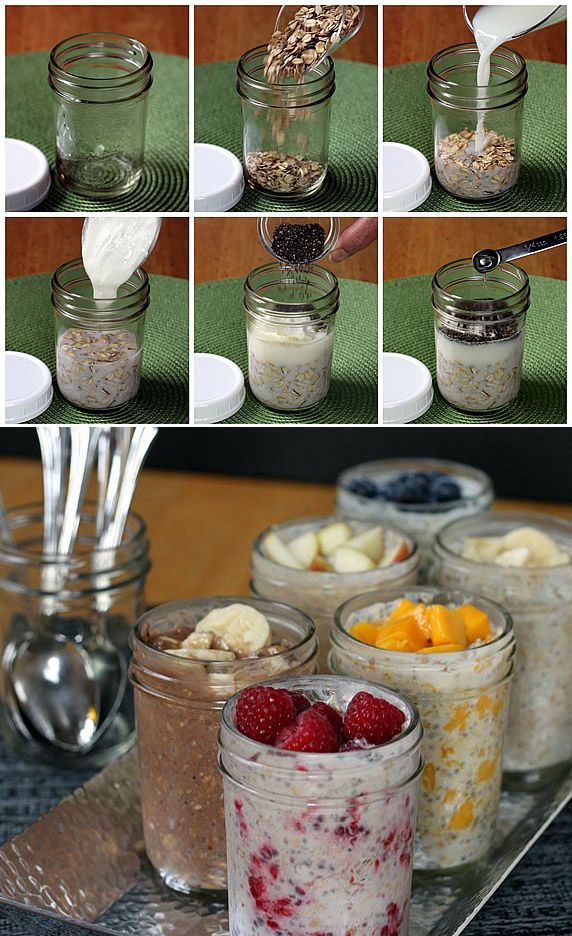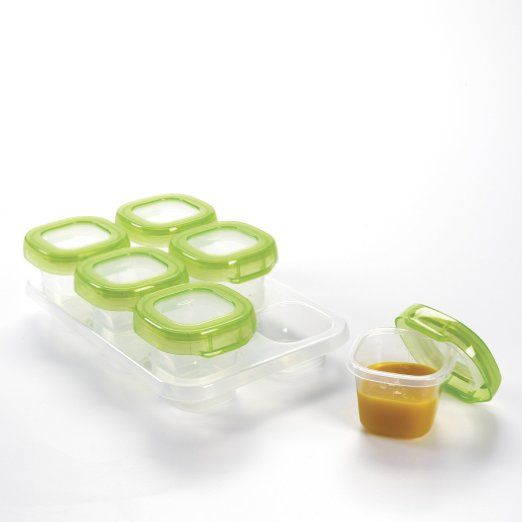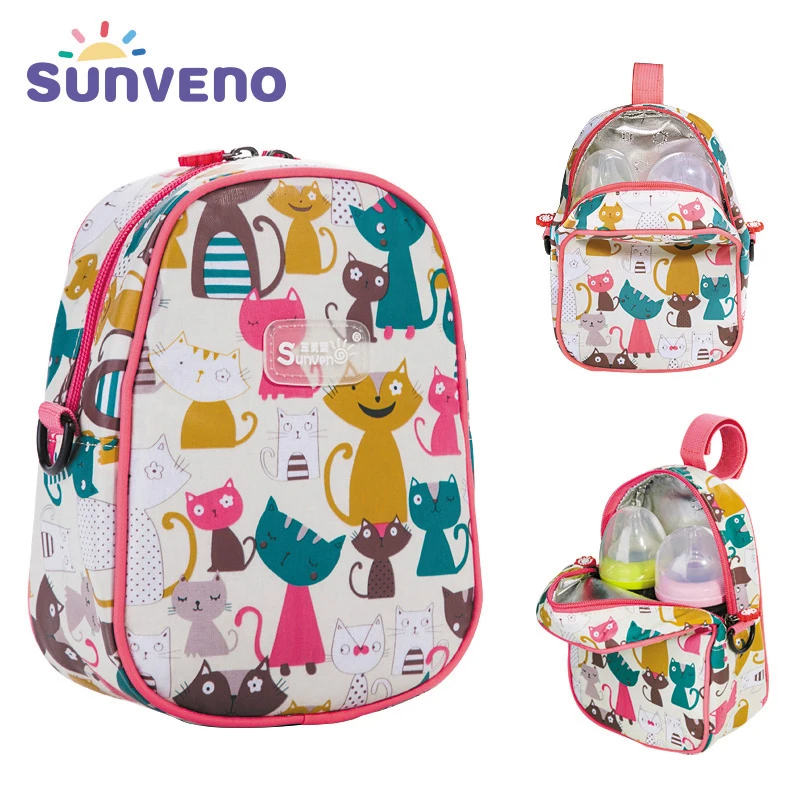Mesh baby feeder for teething
Ultimate Guide to Baby Feeders: Mesh and Silicone
You may have seen baby feeders, whether mesh or silicone, and wondered what they are for. They are a great tool for feeding babies and toddlers—and are especially awesome for teething relief. There are many on the market though, so today I’m sharing the best of the best.
Baby Feeder
A baby feeder is made up of an easy-hold handle and a little pouch with lots of holes. The idea is that the holes allow some of the flavor and texture of the food to come out, without the concerns that may come with larger pieces of food.
This means you can worry less when it comes to choking risks.
One thing to keep in mind: They don’t allow babies to have the full texture experience of the food—since the texture is mostly the mesh of the feeder. That means you don’t want to use one of these for every meal (or even most meals).
Lots of exposures to lots of textures helps babies and toddlers gain confidence in handling all sorts of foods, which can make feeding kids a lot easier over the long run.
But an infant feeder can be a handy tool to have in the mix, especially if on the go, starting to transition to baby food, or trying out a new food that has you a little nervous.
And they are a great way to offer cold teething relief to soothe baby’s gums.
Baby Fruit Feeder
Many people like to use baby feeders to offer fruit, either fresh or frozen, since the product is a safe way for baby to suck on and explore the flavor of a wide range of fruit.
TIP: Another name for this is Baby Fruit Pacifier.
Best Baby Food Feeders
Below are my top picks for infant feeders chosen for ease of use, durability, and ease of care (as in washing!). There are different materials listed, as well as specific information on each product.
Best Mesh Feeder
Munchkin Baby Feeder, sold in a set of two. (Or choose the ones that come with travel caps.)
This baby feeder has a streamlined, simple design of a mesh bag for the food and a ring for baby to hold onto. Small, digestible pieces of food come through so baby is getting some nourishment (and comfort if using for teething) without the risk of choking. It’s about $7 for two of them.
Small, digestible pieces of food come through so baby is getting some nourishment (and comfort if using for teething) without the risk of choking. It’s about $7 for two of them.
Best Silicone Feeder
Boon Silicone Feeder
This baby feeder, which is priced at under $6, is made from durable silicone and can be used with fresh or frozen foods. The interior stem forces food toward the tiny holes in the feeder and the small handle is sized just right for baby’s little hands.
Kidsme Baby FeederBaby Feeder Pacifier Combo
Kidsme Food Feeder
This popular Kidsme feeder has a replaceable silicone pouch that comes in two sizes, so you can adjust and replace as your child grows. It has a unique handle style that some babies may prefer and can be used as a pacifier too. It’s usually priced around $15 and is recommended for ages 4-24 months.
What baby foods should I put into a baby feeder?
Here are some fruits that are good to serve in a baby feeder:
- Raspberries, fresh or frozen
- Strawberries, fresh or frozen
- Blackberries, fresh or frozen
- Cantaloupe
- Honeydew
- Banana
- Mango, fresh or frozen
- Roasted sweet potato
- Roasted butternut squash
- Ripe fresh pear
- Fresh cucumber, skin removed
- Watermelon
- Cooked red meat such as steak
- Frozen grapes (These are NOT safe served to a child this age in any other way as they are a choking risk.
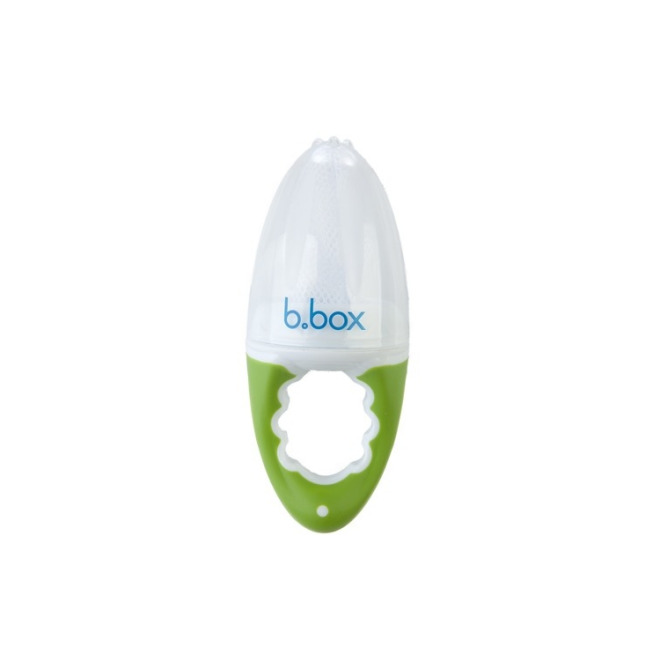 They are fine served inside the feeder, though.)
They are fine served inside the feeder, though.)
TIP: You can use frozen fruit or ripe fresh fruit that’s soft and easy to gum. Avoid any fruits or veggies that are very hard as baby may be frustrated by that texture.
Frequently Asked Questions
What age can baby use a mesh feeder?
Babies can use an infant feeder soon after starting solids around 6 months, or when they can easily hold it and bring it to their mouth.
How do I use a baby feeder to help with teething?
If you fill the feeder, whether mesh or silicone, with frozen fruit, you can soothe teething in infants who are eating solids or in toddlers. It’s cold and yummy, yet requires no real work for the child to suck on, so it’s comforting.
Are all of these baby feeders BPA-free?
Yes, if you choose a mesh baby feeder or one made from silicone, they are BPA-free.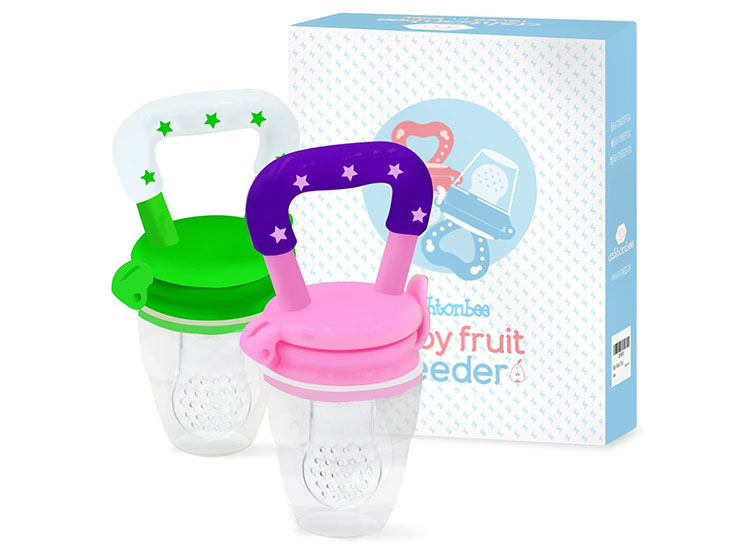
What’s the best way to clean a baby feeder?
Try using a bottle brush or just running water to clean out the mesh. It should be fairly easy to clean if you avoid letting it sit too long with food in it!
Are baby feeders good for babies?
The one downside could be that if you rely on them too much, the child learns the texture of the feeder, rather than of the food. This can make it harder for a child to learn to move actual food around in their mouths and harder for them to accept a range of textures in the future when you don’t want to be using the mesh feeder as much.
Because of that, I recommend using this product at limited times such as when on the go at a restaurant or to help sooth a teething infant, baby, or toddler.
This is not recommended as a way to feed your child at every meal.
If you are worried about choking, review this information on toddler choking and trust that if you serve foods that are easy to squish between your fingers, baby is sitting down at meals, and you are with them, they will learn to eat like so many other kids who have gone before them!
You May Also Like
- Best Baby Puffs
- Favorite Sippy Cups
- Best Snack Containers
- Best Lunch Boxes
- Favorite Suction Bowls
- Top High Chairs
I’d love to hear your thoughts on baby feeders in general or on these specific products, so please comment below to share!
This post was first published May 2019.
5 Popular Baby Food Feeder Options to Keep Baby Safe and Less Messy
Looking for a baby food feeder? Read on to discover the advantages of a baby food bottle feeder, mesh baby food feeder, silicone baby food feeder, reusable squeeze pouch baby food feeder, and a baby spoon feeder. These can help your child learn how to start to transition from baby feeders to more soft foods and someday solid foods as they get older.
I love my kids when are babies, but I don’t always love taking the time to sit there and feed them baby food from a jar (and I certainly don’t love taking the time to make my own baby food purees). I’m all about that baby-led weaning and finger foods! I am a busy mom with other kids and work and school so easy is my approach to introducing baby foods.
I wait until at least 6 months before introducing any type of baby food.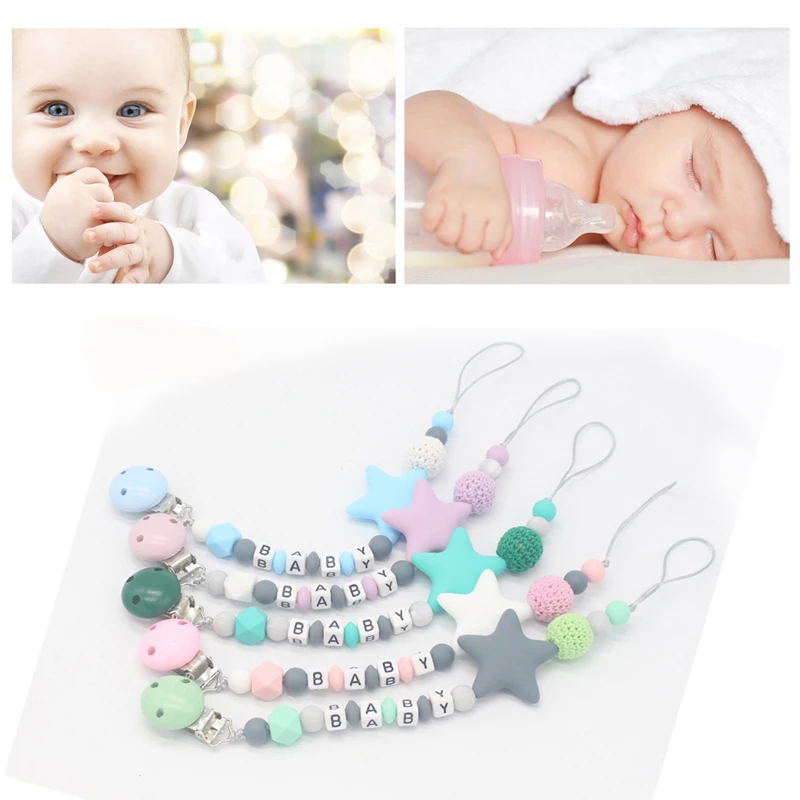 I usually buy some rice cereal and mix it with a little formula or pumped breastmilk (if I have any pumped) and give it a go. I may then try spoon-feeding some simple, single-flavor jarred baby food to my infant.
I usually buy some rice cereal and mix it with a little formula or pumped breastmilk (if I have any pumped) and give it a go. I may then try spoon-feeding some simple, single-flavor jarred baby food to my infant.
Once they get more a hang of the idea of food, and can move food around in their mouth and swallow better, I start giving the baby small, soft bits of whatever we are eating at the table, along with baby-friendly puffed cereals, freeze-dried yogurt bites, and more pureed baby foods perhaps from a baby food feeding pouch.
The biggest fear I have every time I start feeding babies is the fear of them choking.
This is one of my greatest fears, not just at the dinner table, but as they crawl around and find all the tiniest bits of whatever all over the floor and stick it in their mouths! I have pulled so many pieces of paper, leaves, grass, and toys out of my fifth baby’s mouth.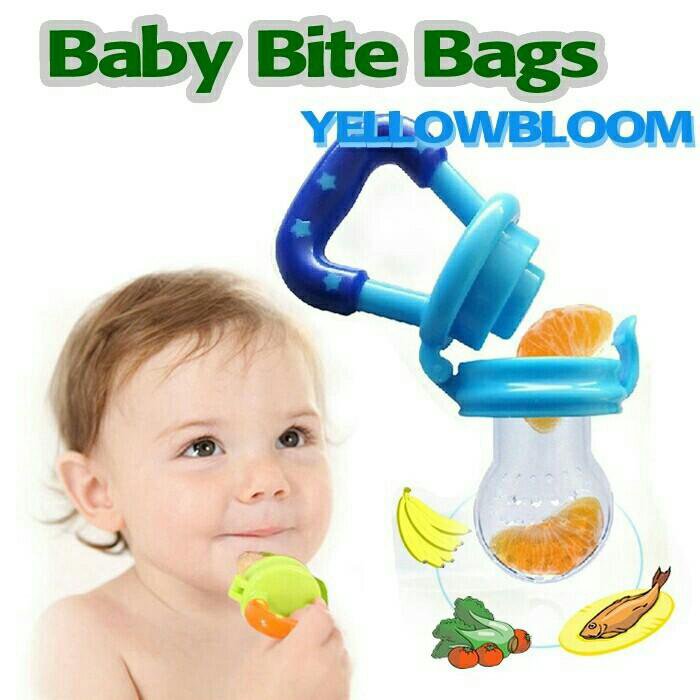 It’s nerve-wracking!
It’s nerve-wracking!
And that’s why I love the idea of a safe baby food feeder.
Why it works for easy feeding
Using useful tools like a mesh baby feeder is perfect for helping your child transition to soft foods and solid foods. It’s also an easy way to help your baby’s gums transition to eating a small size of food as well. Baby fruit feeders are great because they are made of safe materials with tiny holes that allow your child to hold onto the food-grade silicone handle and start to figure out the best way to eat.
This is a great way to introduce small amounts of food to a teething baby or to introduce them to new flavors of food in a fun way.
Keep in mind that a baby’s age and the baby’s diet needs to be kept in mind. Young babies shouldn’t be eating the same thing as an older baby so you still have to be very careful as well.
Use these for little hands.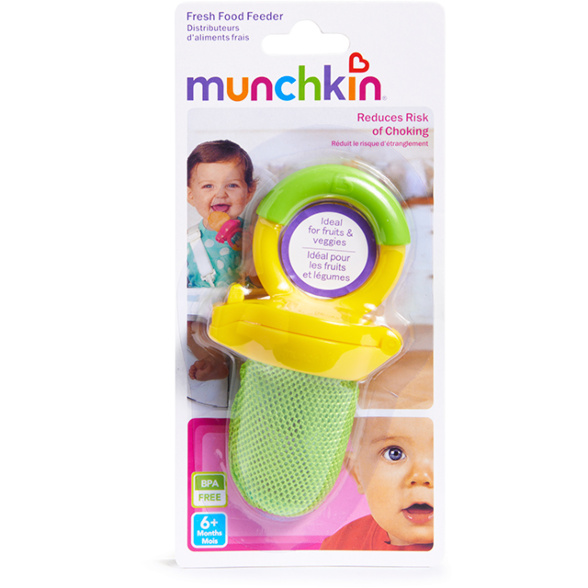 They also work great to work on hand-eye coordination as they’re putting them up to their mouths. I also love that they’re made for easy cleaning, too!
They also work great to work on hand-eye coordination as they’re putting them up to their mouths. I also love that they’re made for easy cleaning, too!
Baby Food Feeder
Using a baby food feeder is a new thing for me to try with my fifth baby, but I like it so much!
Not only does it make feeding babies safer but makes mealtime less messy! (See my post on limiting messy eating toddlers for tips for the slightly older crowd!)
I discovered that there are several very popular baby food feeder options out there today, so I wanted to discuss the various options and what makes them each great or not so great and where you can pick them up.
Munchkin Baby Food Feeder
To help facilitate this discussion, Munchkin sent me a few baby food feeders and a cool sippy cup cleaning brush set to review.
#1 Baby Spoon Feeder
This type of baby food feeder is where you dispense baby food through a baby food dispensing spoon. You simply fill up the soft silicone end with soft pureed foods or things like yogurt and then you squirt baby food out from the silicone part out onto the spoon!
You simply fill up the soft silicone end with soft pureed foods or things like yogurt and then you squirt baby food out from the silicone part out onto the spoon!
I tried ours out with some Greek vanilla yogurt. While it still ending up being messy and it made all sorts of fun “farting” noises as I pushed out air along with the yogurt, which then kinda sprayed everywhere, it was pretty easy to use.
What I like about this versus a bowl or jar that you are spoon feeding your baby from, is there is less back and forth from the jar or bowl to the baby’s mouth. When babies are at the “swat at everything” stage, it means less chance of baby food ending up on the floor, or my lap.
So, still kinda messy but better!
It’s pretty easy to clean out, and you can take the squeeze feeding spoon on the go as it comes with a hard plastic cover you just snap on to the end of the spoon.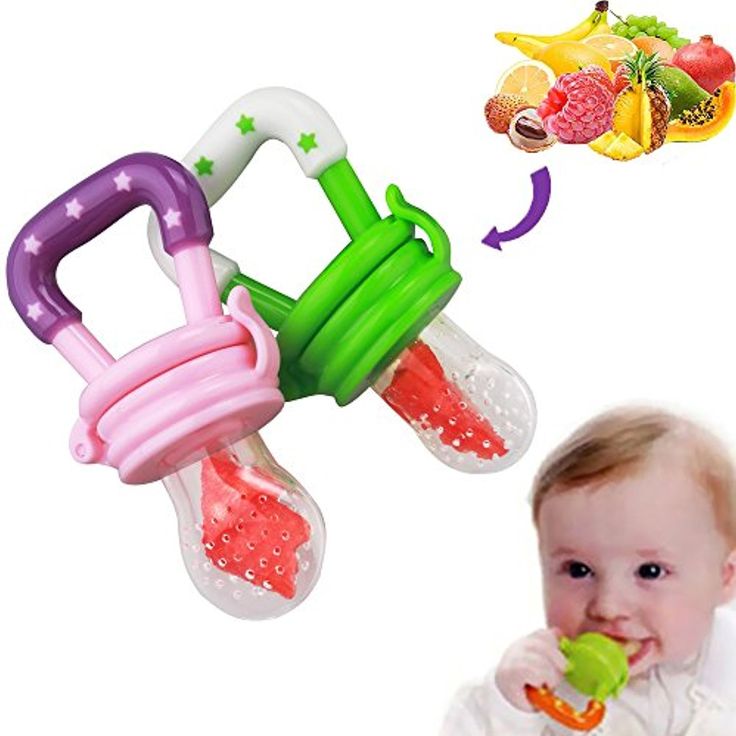
They come in colors blue, green, and pink and are $7 each on Munchkin.com. You can also find them on Amazon (though for more).
Munchkin Baby Mesh Feeder
I have seen many friends over the years who use and love these mesh baby food feeders (and even pediatric occupational therapists highly recommend mesh feeders)! They are especially handy as a baby teething feeder! You can put some frozen raspberries or other frozen fruit or even an ice cube in it and let your baby safely gnaw and gum it, cooling their poor aching teething gums!
The Munchkin fresh food feeder is perfect in that you can give your baby chopped up pieces of fresh fruits and vegetables without having to puree them to a pulp! The mesh prevents large pieces from coming through so they won’t chock on the fresh food! Yeah!
I put some cut grapes, pieces of chicken, and more in mine when I tested it out to give to my 8-month old baby.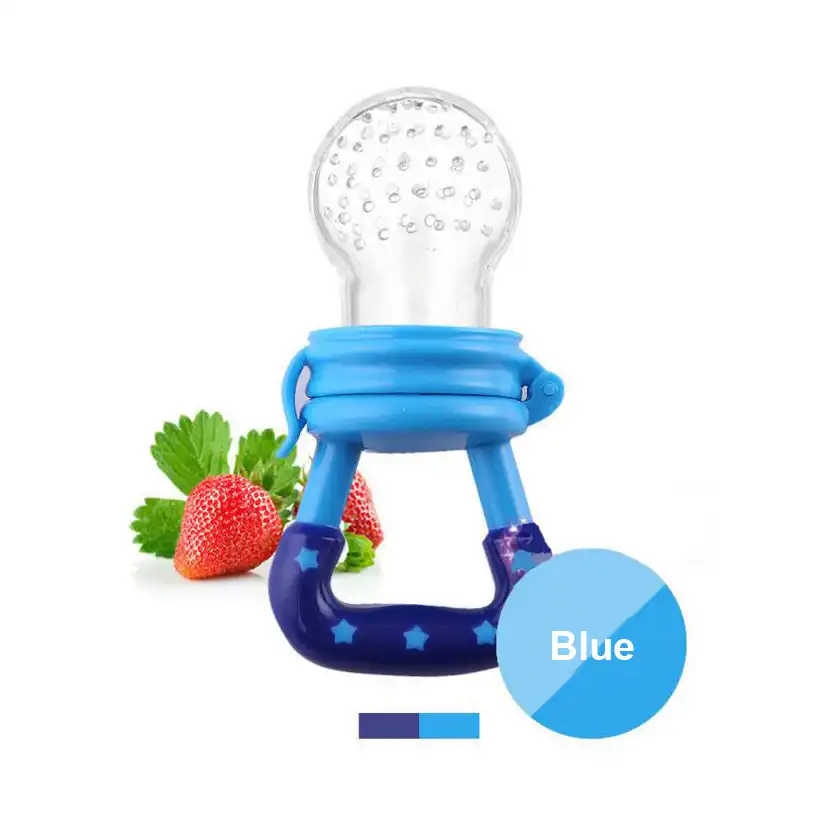 She loved gnawing on it!
She loved gnawing on it!
Some of the best foods for a mesh feeder include:
- raw apples
- chunks of melons
- frozen blueberries
- pears
- peaches
- raw carrots
- nectarines
- chunks of meat
It is recommended to empty and wash out your mesh feeders shortly after use to make it easier to clean out and prevent any food going bad in there! I found it super easy to rinse out with a little dish soap at my sink. But some foods like bananas can be more difficult to clean out of it.
The Munchkin Fresh Food Feeder comes in pink/purple, green/blue, and yellow/green colors for $3 each on Munchkin.com. You can also opt for one of their Munchkin Deluxe Fresh Food Feeders that come with a convenient on-the-go cap with snap-tight closure for $4 each on Munchkin.com. Amazon has the 2-pack fresh food feeders that I received for $5.99.
Munchkin Silicone Baby Food Feeder
Similar to the above fresh baby food feeder, there is also a Munchkin silicone baby feeder too (but I didn’t receive this product to try out).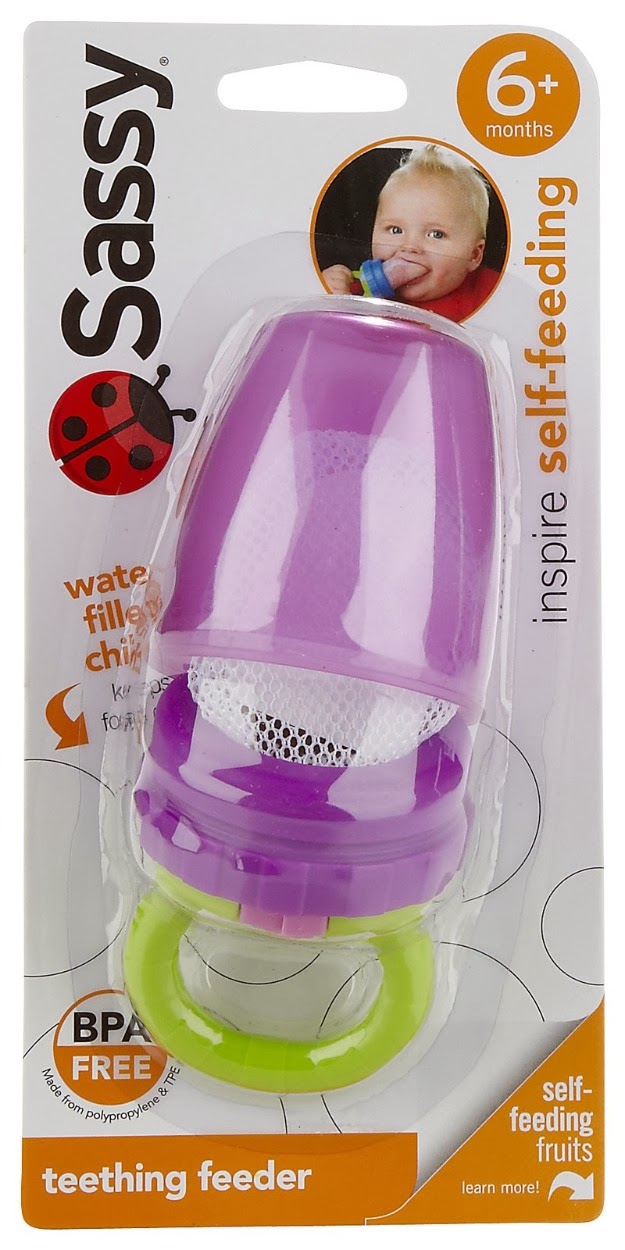
The silicone baby feeder is actually designed for babies ages 4+ months whereas the other ones are designed for babies 6+ months old.
The silicone baby food feeders are easier to clean, but smaller and actually designed for baby food purees rather than large fresh food, though some people still put large pieces of food in them (but it’s harder to fit them in these).
Munchkin silicone baby food feeders come in pink, green, and blue and includes an on-the-go cap for $4.50 on Munchkin.com.
Baby Food Bottle Feeder
I don’t use baby bottles hardly at all, so maybe that is why I had never heard of a baby food bottle feeder before!
There are some bottle manufacturers that offer alternative bottle tips that allow you to squeeze out baby food from inside the bottle to the base of a replacement bottle head – a food dispensing spoon!
With our baby twins we had used baby bottles that could swap out tips for sippy cup tips, and we used those silicone sippy cup nipples with moderate success (until they got teeth and stuck utensils, pencils, and other objects into the opening making anything but spill-proof). The baby food feeder bottle nipples also make sense!
The baby food feeder bottle nipples also make sense!
It doesn’t appear like there are many bottle companies that actually make these anymore. Nuby used to make one called the Nuby Infa Infant Feeder and the Nurtur Care Infa Feeder but they are no longer available for purchase. I did find that Sassy offers a baby food nurser bottle (on BuyBuyBaby and Amazon).
The cool thing about this product is that it has a vacuum disc that keeps air out and moves cereal or baby food without clogging. Plus there is a handy travel cover so you can take baby food on the go much easier. The spoon is also like a soft nipple which is easier on those little mouths than a regular spoon.
Reusable Squeeze Pouch Baby Food Feeder
I recently got a reusable squeeze pouch baby food feeder from Noobie Box‘s Noobie Eat Box. I have always wanted one of these because I hate how wasteful and expensive all these baby food pouches out there! You can easily fill one of these up with apple sauce, your own fruit purees, or yogurt and save yourself a ton of money, time, and trash!
Squeeze pouches are super handy for feeding soft pureed foods to babies (and older kids too – let’s be honest!), especially on the go! No utensils required and when they get older can safely suck them down themselves without making any messes.
My baby at 8-months old cannot manage one of these on her own (she loves to squeeze them) but uses baby food squeeze pouches has helped her develop some sucking skills, skills that will come in handy when introducing sippy cups with straws.
If you are interested in picking up reusable squeeze pouches, there are many options on Amazon from brands like Squooshi, WeeSprout, Baby Brezza, Kiddzo, and others costing about $9.99-$19.99 for multiple reusable pouches.
Munchkin does not carry any baby food pouches, but they do have Click Lock Food Pouch Spoons! They work with most leading pouch brands. The spoons are twisted onto the ends of the pouches, allowing you to squeeze baby food from pouches onto a baby-friendly spoon. They’re designed for kids ages 4+ months. It’s pouch feeding without the mess (hopefully).
You can get a 2-pack of the Munchkin Click Lock Food Pouch Spoons for $4 on Munchkin.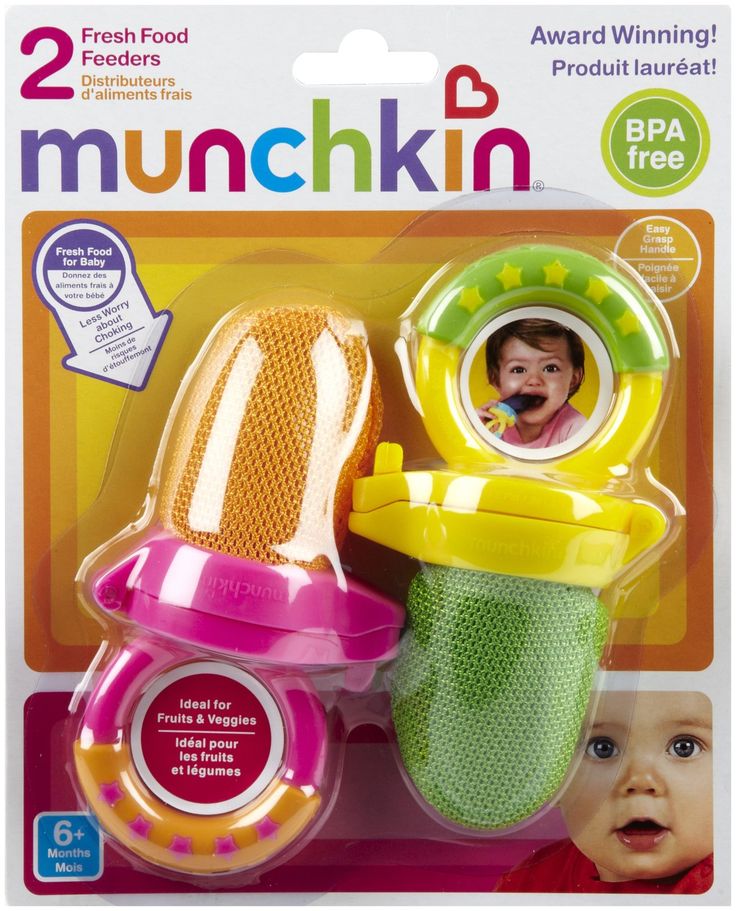 com.
com.
If you want to pick up several of these great Munchkin baby food feeders, remember that you get FREE Shipping on Munchkin.com Orders Over $25 + FREE Returns! Plus, you can also Sign up to receive an additional 10% OFF!
I’m so glad there are so many great and innovative baby brands making products to help me feed my baby safer and cleaner!
I’d love to know what you’ve thought about various baby food feeders you’ve used over the years, sharing your own reviews of which one(s) is your favorite.
Be sure to check out these other great posts:
- Thrifty Mom’s Guide to Essential Baby Feeding Supplies
- 15 Must-Have Baby Items
- How to Take Care of a Baby’s First Teeth
- How to Transition Baby from Bottle to Sippy Cup
- What Happens When You Grow Up to Be a Picky Eater Adult
Temperature during teething: causes, duration
When teething, the child's body experiences severe stress and reacts to it with increased temperature.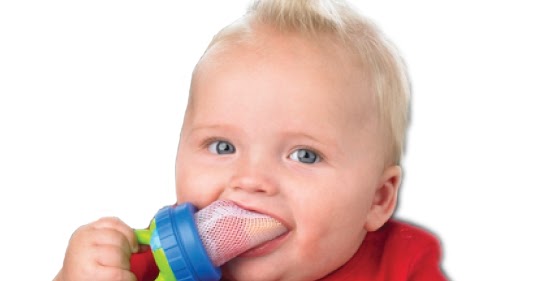 In order not to confuse a common cold with a temperature during teething, you need to know what exactly happens when teeth are cut.
In order not to confuse a common cold with a temperature during teething, you need to know what exactly happens when teeth are cut.
The reason for the rise in temperature during eruption
The temperature occurs for a reason. The child's body reacts in this way to the inflammation of the gums that has appeared, through which the tooth will soon come out. At this time, the immunity at the site of the future tooth decreases, and various microorganisms begin to activate, which also cause temperature.
Up to a year, teething is more or less calm and does not cause severe inconvenience, but after a year, when fangs begin to erupt, which take longer to appear, the baby may experience pain accompanied by fever, up to several weeks.
Often the temperature rises not because of inflammation of the gums, but because of viruses that have entered the body or infection due to reduced immunity. The body with its help fights with them, because they are not able to exist at high temperatures, so they die.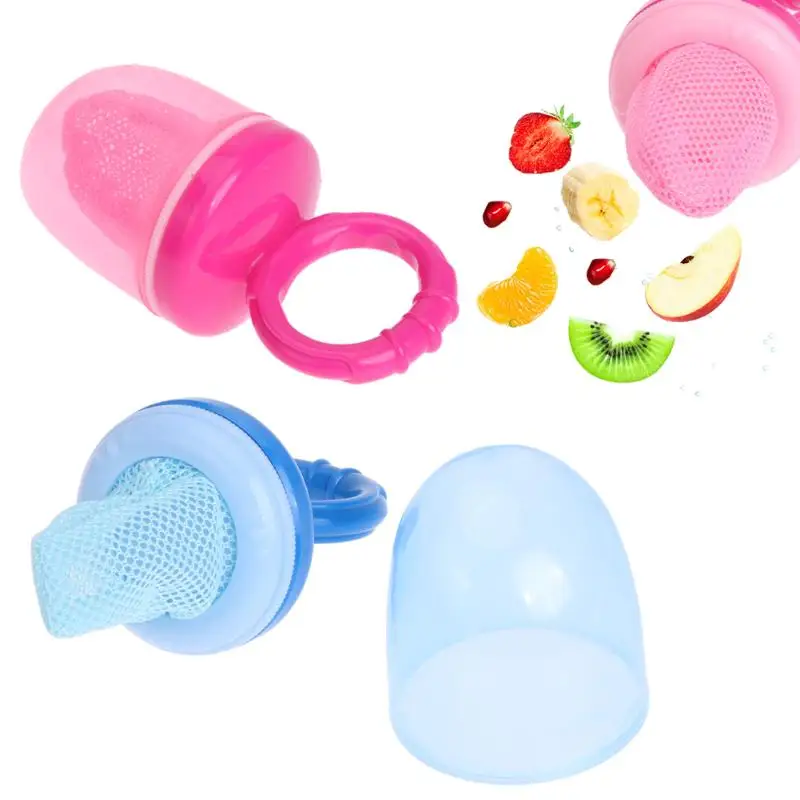
How high can the temperature rise?
How much the temperature will rise, individually for each organism. Normally, it can vary from 37.5 to 38.5 degrees. It is necessary to measure the temperature every half an hour or an hour, because in young children it can rise very quickly, because their body is still unable to properly perform heat exchange.
If the temperature began to reach a value of 39 degrees, then you must immediately call an ambulance, because this may mean the appearance of various complications.
Duration
Regardless of the examples given, all organisms react differently, so things can develop differently for different children. Usually the temperature lasts 2-3 days and disappears when the tooth erupts. There are also cases when the temperature lasts for 5 or even 7 days, and the temperature can rise and disappear completely after a few hours.
Be that as it may, the doctor still needs to be called to examine the baby.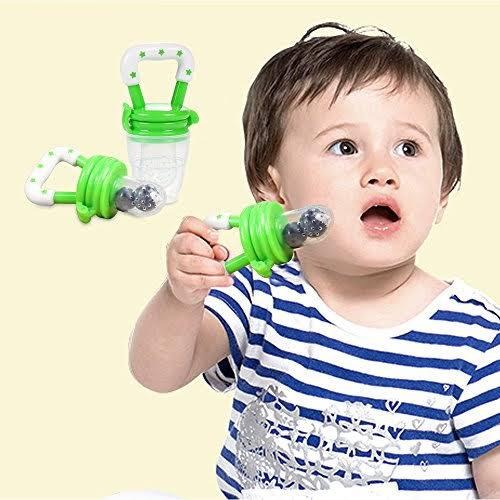 To exclude complications and a number of other diseases, in which case they should be treated as early as possible.
To exclude complications and a number of other diseases, in which case they should be treated as early as possible.
What are the symptoms other than fever?
Fever is not the only sign of teething. In parallel, a runny nose may join due to the spread of edema from the gums to the nasal mucosa. This happens when the upper teeth erupt.
Also one of the symptoms is profuse salivation and weakening of the baby's stool.
What symptoms should alert?
Due to reduced immunity, the child's body is not able to fight many viruses and infections. The following signs may indicate their presence:
• the nose is very stuffed up, and snot flows from it in large quantities. This means that rhinitis has joined the edema, it must be treated;
• diarrhea. Very rarely it appears along with the temperature, but still happens. This may mean some kind of intestinal infection brought by the baby with the help of toys;
• cough.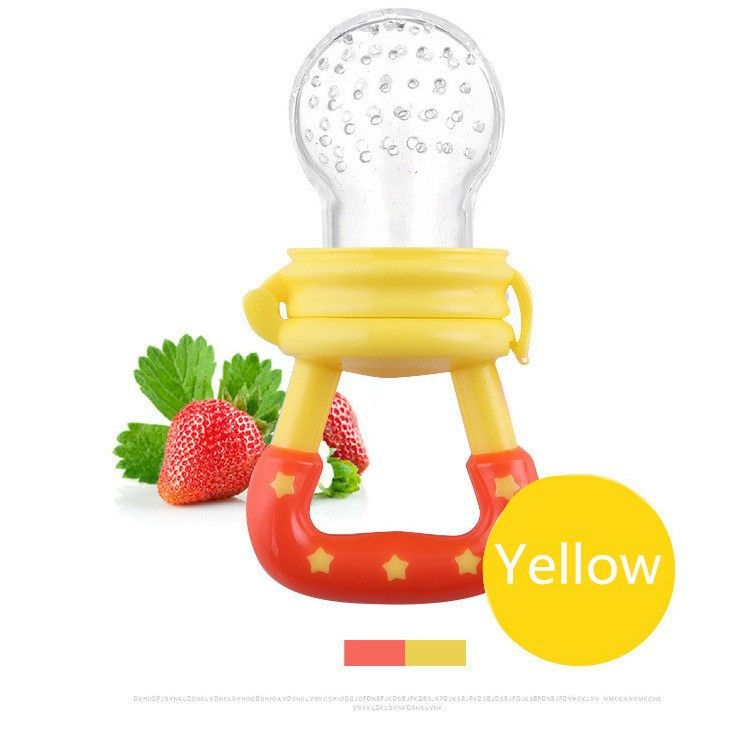 Because of the strong salivation, children do not always have time to swallow saliva, so sometimes they can choke on it, as a result of which they cough. If the cough is repeated systematically and at the same time there are signs of outgoing sputum, then inflammation of the respiratory tract has joined the temperature;
Because of the strong salivation, children do not always have time to swallow saliva, so sometimes they can choke on it, as a result of which they cough. If the cough is repeated systematically and at the same time there are signs of outgoing sputum, then inflammation of the respiratory tract has joined the temperature;
• reddened throat. In addition to the nasal mucosa, edema can also pass to the mucous membranes of the neck. This may mean the appearance of pharyngitis or acute respiratory infections;
• nausea and vomiting. Occur at a very elevated temperature, perhaps this is a symptom of an intestinal infection or damage to the nervous system.
If the baby has these signs, you should immediately consult a doctor who will prescribe the necessary treatment, regardless of the presence of temperature.
What measures should be taken in case of high temperature?
Many parents start antipyretics and antivirals when they have a mild fever. You can’t do this, because you need to allow the body to fight the virus on its own.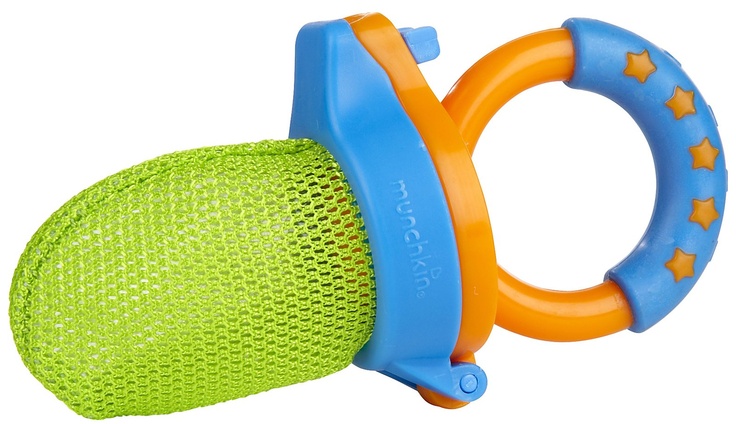 The abuse of such drugs can lead to addiction, and in the future the body will not be able to cope with infections and viruses on its own. Pediatricians advise not to bring down the temperature until it reaches 38 degrees, because you need to let the body fight.
The abuse of such drugs can lead to addiction, and in the future the body will not be able to cope with infections and viruses on its own. Pediatricians advise not to bring down the temperature until it reaches 38 degrees, because you need to let the body fight.
If the effectiveness of antipyretics is low, you can wipe the baby with a little cool water or rub with an alcohol solution with the addition of vinegar.
Sometimes parents resort to a method such as homeopathy, but with the help of these remedies it will not be possible to effectively reduce the temperature, although they can generally improve the condition of the crumbs.
If the temperature does not subside for more than 3 days, you should consult a doctor.
Is it possible to walk in the temperature?
If the baby is feeling well and the temperature is not too high, then a walk in the fresh air will only benefit. Only the child needs to be dressed according to the weather. You need to walk calmly so that he does not overwork.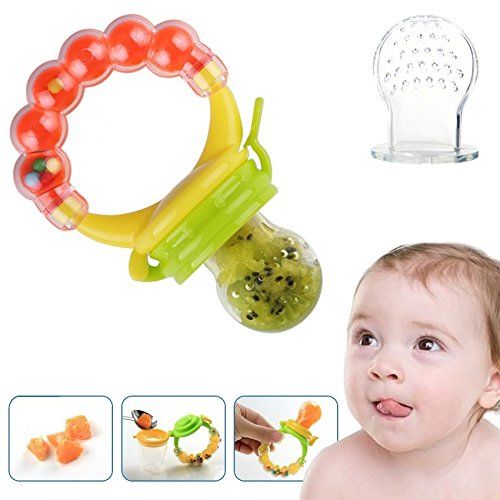
Even if there is confidence that the temperature is a consequence of teething, you still need to call a doctor who will make an accurate diagnosis and prescribe the right treatment. Self-treatment in this case is unacceptable, because in case of an error, you can harm the health of the baby.
Sign up for treatment and consultation with a pediatric dentist!
The first teeth - articles from the specialists of the clinic "Mother and Child"
Bogorad Maria Vladimirovna
Ophthalmologist, Ophthalmologist for children
Clinic "Mother and Child" Kuntsevo, Clinical Hospital Lapino-1
When to expect
The milk teeth of the future baby are laid at the 7-8th week of intrauterine development, and the permanent ones - at the end of the 4th month of pregnancy. In total, 20 milk teeth are laid in a child, while permanent ones - 32. To provide the crumbs with a Hollywood smile, the expectant mother needs to eat right throughout all nine months of pregnancy.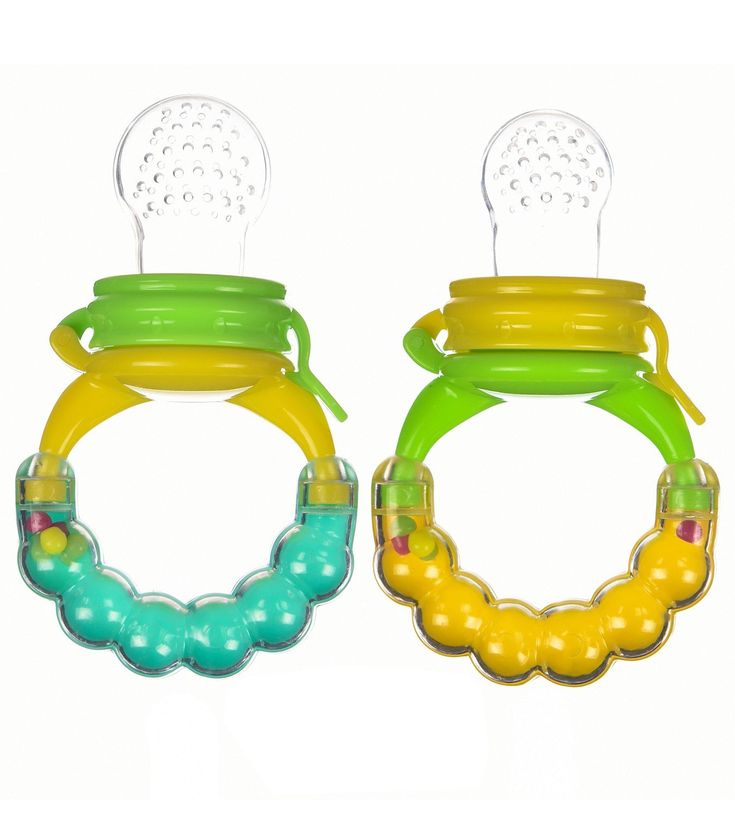 There are no calcium preparations that would be 100% absorbed, so it is very important to draw “natural” calcium from food, especially cottage cheese. And, of course, the most pregnant woman needs to cure all her teeth - now there are very sparing technologies for this.
There are no calcium preparations that would be 100% absorbed, so it is very important to draw “natural” calcium from food, especially cottage cheese. And, of course, the most pregnant woman needs to cure all her teeth - now there are very sparing technologies for this.
The eruption of the first milk teeth in most cases begins at the 3-8th month of a baby's life and ends closer to three years. But it also happens that children are born already with one or two teeth, or teeth can erupt in the first weeks of life. Often the timing of teething depends on genetic characteristics, but much more - on other factors. They affect the teeth and diseases of the crumbs (for example, with rickets, frequent SARS and dyspepsia, teeth erupt later). It is worth paying attention to the nature of nutrition, the quality of drinking water, even the climate! In northern residents, teeth erupt on average a little later than in southerners. Sometimes teething is delayed, and the first tooth appears closer to the year.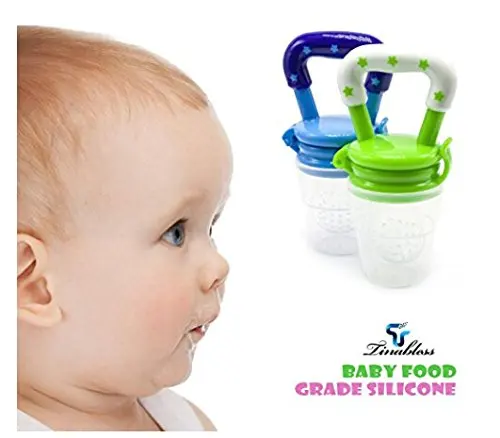 Usually there is nothing wrong with this. It is believed that not so much the timing as the order of teething speaks about the health of the child. If it is broken, pay attention to this fact and show the baby to a pediatric dentist.
Usually there is nothing wrong with this. It is believed that not so much the timing as the order of teething speaks about the health of the child. If it is broken, pay attention to this fact and show the baby to a pediatric dentist.
The process has begun
Profuse salivation indicates that the teething process has begun. In addition, the baby begins to pull into his mouth everything that only comes to his hand. This means that the gums itch, causing him discomfort. Trying to relieve itching, the baby instinctively acts correctly - micro-massage of the gums improves microcirculation in them, teeth erupt easier and faster. During this period, provide the child with teethers: hypoallergenic silicone toys filled with water. The teether should not be cooled in the freezer - only in the refrigerator: otherwise the crumb will get hurt on a hard surface. If the gums are very swollen, and the baby is crying in pain, use special dental gels that have a mild local anesthetic effect.
For most children, the process of teething goes fairly smoothly. There may be short periods of anxiety, violations of the regime of the day and nutrition. Sometimes even teething is accompanied by diarrhea, runny nose, cough and fever. And during the period of the appearance of teeth, the baby is vulnerable to all kinds of infections. The immunity of the crumbs decreases these days, and it is easier to “pick up” the virus, so it’s not worth writing off the worsening of the condition only on the teeth. If a child has a fever when a tooth is cut, it is necessary to look for another inflammatory focus in the body.
At 6 months the baby usually boasts central lower incisors. This is an excuse to start brushing your teeth. Why so early? Milk teeth are small and sharp, have an uneven wavy edge, are close to each other and, as a rule, have a yellowish tint. These teeth have a low degree of mineralization. Their enamel and dentin are very thin. All this contributes to the rapid emergence and spread of caries. In order to prevent it, you need to brush your teeth regularly: for this, you can use various massage brushes that not only teach the child to hygiene, but also facilitate the process of teething. Teeth are immediately taught to clean correctly - from the gums to the edge, slightly "sweeping", semicircular movements, and in no case horizontal. If possible, brush your teeth after every meal (and at least twice a day). Is there no such possibility? Give the baby a drink - the water will wash away the remnants of food.
In order to prevent it, you need to brush your teeth regularly: for this, you can use various massage brushes that not only teach the child to hygiene, but also facilitate the process of teething. Teeth are immediately taught to clean correctly - from the gums to the edge, slightly "sweeping", semicircular movements, and in no case horizontal. If possible, brush your teeth after every meal (and at least twice a day). Is there no such possibility? Give the baby a drink - the water will wash away the remnants of food.
At 8 months the upper central incisors usually erupt. In 9 months the upper lateral incisors appear. At 11 months and the lower lateral incisors are already in place in many children! By , the baby has eight normal teeth . But there may not be a single one - delayed teething occurs in 25% of cases with normal psychomotor development of the child. In extremely rare cases, the absence of teeth is associated with adentia - the absence of their rudiments.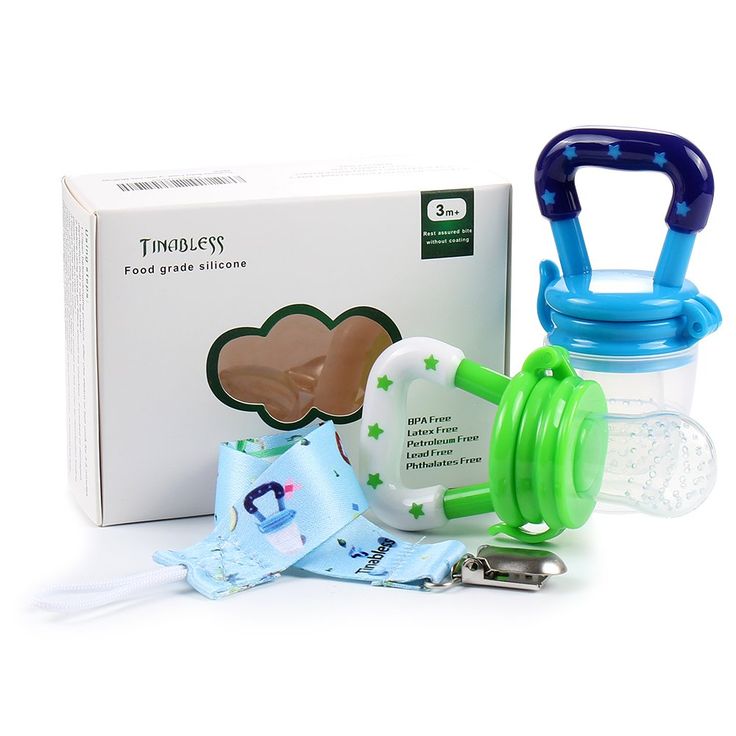 You can check this with a pediatric dentist using the radiovisiography method. By 13–15 months , first the upper first molars appear, and then the lower ones.
You can check this with a pediatric dentist using the radiovisiography method. By 13–15 months , first the upper first molars appear, and then the lower ones.
From the age of one, the baby's teeth can be brushed with children's toothpaste and a special children's brush. The service life of the brush is no more than 2 months, even if it looks like new. Many babies swallow delicious pasta. You should not be afraid of this if it is childish and its quantity is no more than a pea. Of course, up to 2–2.5 years, brushing your teeth should be done with the help of, and then under the vigilant control of your mother.
B 18 months fangs erupt. Usually these teeth cause more problems than others, their eruption is more painful, and this process is often accompanied by malaise. At 20 months the second molars erupt. And sometimes already at this age, the mother may notice the first problems. Doctors reassure: carious milk teeth are not a reason to worry that permanent ones will also be bad. As practice shows, there are no regularities here. Of course, if parents do not neglect the prevention of diseases and dental hygiene. At 2.5 years old, a normal baby has a full set of milk teeth. There are 20 of them - 10 on each jaw .
As practice shows, there are no regularities here. Of course, if parents do not neglect the prevention of diseases and dental hygiene. At 2.5 years old, a normal baby has a full set of milk teeth. There are 20 of them - 10 on each jaw .
Milk teeth do not last long - soon they will fall out and permanent ones will appear in their place. Usually the change of teeth begins at about 5-6 years and lasts until 20, when the wisdom teeth erupt.
From the age of 6 months, it is obligatory to come for preventive examinations twice a year. When this becomes a habit, the baby will not be afraid of doctors, and by the age of 7–8 (when a visit to the clinic can no longer be avoided) he will sit in the dental chair quite calmly
In order for the baby's teeth to grow strong and healthy, you need to start taking care of them almost before conception. And it is also better to get to know the dentist early
Terms of eruption and loss of milk teeth
| Upper teeth | |||
| Tooth name | Eruption period | Eruption procedure | Drop time |
| Central cutter | 8 months - 1 year | 2 | 6-7 years old |
| Side cutter | 9 months - 1 year 2 months | 3 | 7-8 years old |
| Fang | 1 year 3 months - 1 year 10 months | 7 | 10-12 years old |
| First molar | 1 year - 1 year 6 months | 5 | 9-11 years old |
| Second molar | 2 years - 2 years 8 months | 10 | 10-12 years old |
| Lower teeth | |||
| Central cutter | 6 months -10 months | 1 | 6–7 years old |
| Side cutter | 10 months -1 year 4 months | 4 | 7-8 years old |
| Fang | 1 year 4 months - 2 years | 8 | 9-12 years old |
| First molar | 1 year 2 months - 1 year 7 months | 6 | 9-11 years old |
| Second molar | 1 year 10 months - 2 years 8 months | 9 | 10-12 years old |
Make an appointment
to the doctor - Bogorad Maria Vladimirovna
Clinical Hospital Lapino-1 "Mother and Child" Clinic "Mother and Child" Kuntsevo
Pediatric Ophthalmology for ChildrenOphthalmology
By clicking on the submit button, I consent to the processing of personal data
Attention! Prices for services in different clinics may vary.

